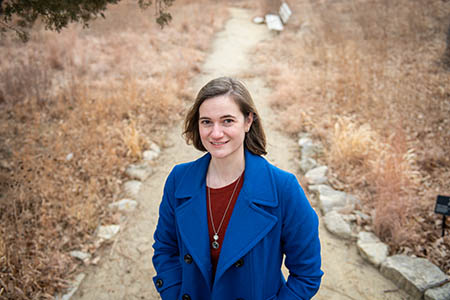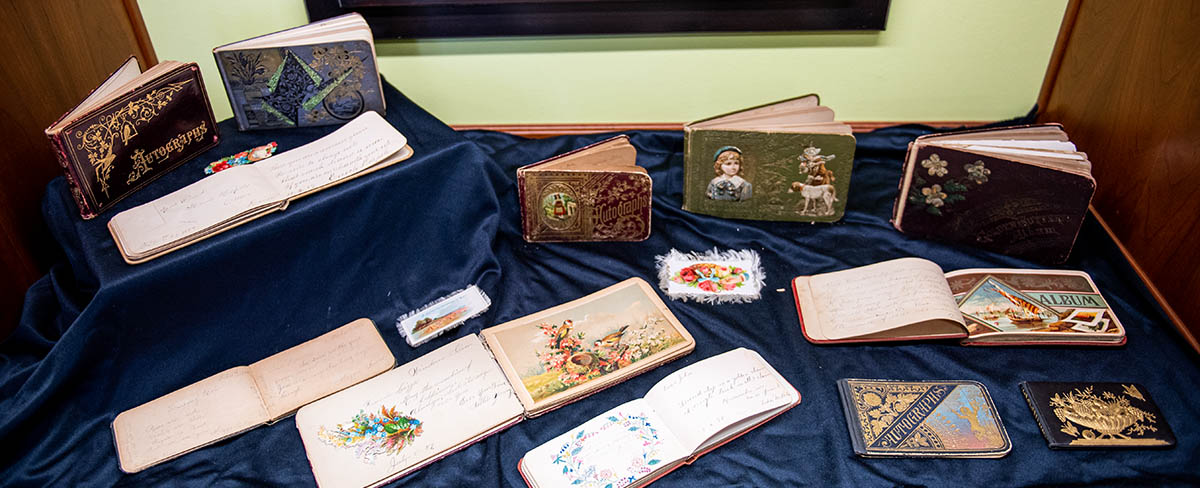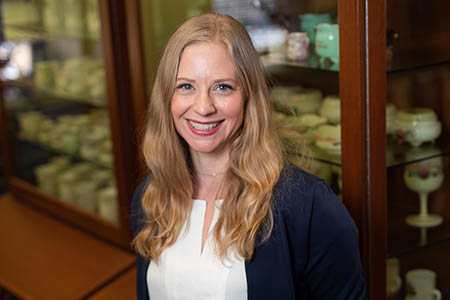Chapman Center for Rural Studies strengthens communities while advancing student learning
Rural research and community collaboration
By Malorie Sougéy
Seek more
View the Chapman Center blog, The Rural Telegraph, and take a behind-the-scenes look at the center.
Follow the Chapman Center on Twitter.
The Chapman Center for Rural Studies aims to preserve and promote the stories and culture of Kansas with a specific focus on rurality. It is a center of excellence in the Kansas State University College of Arts and Sciences.
Mary Kohn, director of the Chapman Center since August 2020 and professor of English, outlines three major responsibilities of the center:
- Give students high-quality, hands-on learning experiences.
- Serve local — especially rural — communities.
- Equip faculty to productively work with students and communities.
“We encourage collaboration between communities, students and faculty to answer the hard questions about what it means to be rural, how we support rural communities and how we preserve their stories,” Kohn said.
The future looks bright, too. Recently, the Chapman Center, in partnership with the English department, received a $20,000 Digital Infrastructure Challenge grant from the National Endowment for the Humanities. The grant will allow the center to create a new digital platform, refresh past online exhibits and create platforms for new projects, all to further the center’s mission.
“The Chapman Center offers a platform for students, faculty and the community to come together in ways we don’t always see in other educational experiences,” Kohn said. “The faculty and students witness the real impact of their work and showcase it to a larger audience, and the work gets used by communities in real ways. To me, that’s the magic of the Chapman Center.”
The following research projects attest to the wide scope and influence the Chapman Center has at the university, in local communities and across the state.
Wildfire and landscape conservation
Wildfire events have increased in size and frequency in the southern Great Plains region over the past few decades. Hundreds of square miles of Kansas land burned in 2021 alone.

Left: Audrey Joslin is improving land management in rural communities by increasing awareness of wildfire best practices.
Audrey Joslin, assistant professor of geography and geospatial sciences, leads the Wildfire and Landscape Conservation project, the Chapman Center’s flagship program that recently received a $466,000 National Science Foundation grant.
Joslin works alongside Marcellus Caldas, professor of geography and geospatial sciences, and Jason Bergtold, professor of agricultural economics in the College of Agriculture, to conduct research on regional perceived wildfire risks and land management.
Often the first to respond to wildfires are rural farmers and ranchers, who call upon their informal network of neighbors and friends to help them until firefighters arrive. According to Joslin, these are the same people who make decisions about land management.
“My collaborators and I hope that increasing knowledge about the dynamics of land management and emergency response in fire-prone landscapes will help rural communities and land managers strengthen their efforts to address wildfire while continuing to support land stewardship activities,” Joslin said.
The research team is interviewing emergency workers and members of wildfire response networks to gain insight on their experiences and identify patterns of collaboration. They also are collaborating with the Farm Service Agency and the Kansas Forest Service to collect data on land use and wildfire events.
In addition to journal publications, Joslin’s team anticipates developing outreach materials to report their findings back to participating communities.
Joslin is a geographer who joined the faculty of the K-State geography and geospatial sciences department in 2016. She examines the interactions between nature and society, and her research advances knowledge on environmental governance and the socio-political dimensions of conservation programs.
Autographed by Kansas

Above: These are some of the Kansas autograph books that Kim Westcott, senior in history, analyzes as part of her Autographed by Kansas project.
You might not think there’s much you can tell from an autograph, but Kim Westcott knows otherwise. Westcott, senior in history, leads a project where she analyzes, digitizes and preserves Kansas autograph books from the late 19th century.
These books — donated by Rosalea Postma-Carttar — contain handwritten signatures and inscriptions, which include sharing memories, personal and professional encouragement, poetry and more. Such autograph books were kept primarily by women as a way to stay connected to friends and family, and they have been evaluated as a predecessor to modern social media.
Not only do these books reveal snippets of general history, but they also uniquely highlight the moment young women began to enter college for the first time in Kansas.
Westcott is investigating other historians’ work on autograph albums, researching the albums’ original owners and finding the narratives within the signatures, which often contributes to a narrative about women’s progress.
Future plans for this project include the addition of an autograph album archive, which will include a literary review of materials demonstrating the importance of autograph albums and their significance in assessing gender roles in the 19th century.
“My hope for this project is that it will be accessible for people to learn about these amazing everyday women and their impacts on history,” Westcott said.
Seek more
Learn more about Kim Westcott’s project with the #autographedbyKansas hashtag on Twitter and Facebook.
The layered history of Kansas land treaties
We all know a spot in Manhattan that we love full well, but do we know the layered histories of the land K-State calls home? Lisa Tatonetti, professor of English, is leading the Kansas Land Treaties project with Mary Kohn, professor of English, to shed light on the topic.
Students and faculty are conducting interviews and place-based research for this project, which tells the story of the treaties between the Kanza, or Kaw Nation, and the U.S. government. The project is supported by a Humanities Kansas grant.
As part of the project, the treaties — which provided land for K-State’s land grant, among other interests — are being annotated as part of an online exhibit. Tatonetti’s team is creating educational materials to promote understanding of these key land cessions, which dispossessed the Kaw people of their traditional homelands.
“This project makes visible the layered and complicated histories of the land we stand on,” Tatonetti said. “It’s our responsibility as citizens and educators to recognize and share the knowledge of how, after generations of Kaw people had lived, had raised their families and were buried on these lands, they could be forced to relocate their entire nation to present-day Oklahoma. Having educational tools available that blend primary documents with video clips, timelines and maps invites everyday people to acknowledge and share this important history.”
Perhaps most importantly, this project has built strong relationships with folks who can share knowledge about both these 19th century treaty encounters and the perspectives of present-day Kaw people.
Tatonetti is a professor of English and co-president of the Western Literature Association. She specializes in Native American literatures and her most recent book is "Written by the Body: Gender Expansiveness and Indigenous Non-cis Masculinities."
Supporting bilingualism in rural Kansas

Right: Mary Kohn is the director of the Chapman Center for Rural Studies and a professor of English. She has led the Chapman Center since August 2020.
Alisa Garni, associate professor of sociology, and Mary Kohn, professor of English, are leading the Prairieview project, which investigates bilingualism in rural Kansas — particularly in one town, given the pseudonym Prairieview to protect residents’ privacy.
The researchers are interested in how bilingual teens in rural communities create enclaves to support each other and their families. An important factor in that conversation is immigration.
“Many people consider Prairieview to be a ‘new rural immigrant destination,’ but it is part of a region with the oldest migratory history in the country,” Garni said. “ Recent immigration to the town follows an unusual 60-year lull in a history of immigration that is thousands of years old.”
Garni and Kohn want to know how recently arrived bilingual youth in Prairieview navigate the ideological monolingualism stemming from this unusual lull, and how multiculturalism and multilingualism might take root in the future.
The team began ethnographic research on Prairieview, including participant observation and in-depth interviews with bilingual youth.
When the COVID-19 pandemic forced the team to remain local, they incorporated new technology to virtually conduct these studies. Undergraduate students on the team were trained to conduct interviews, and they are examining both barriers and support systems that affected rural teens during their online education experience.
The research team is currently drafting a manuscript for a peer-reviewed scholarly journal.
Garni is an associate professor of sociology in the sociology, anthropology, and social work department in the College of Arts and Sciences. She joined the faculty in 2008, and her substantive interests include international development, migration and social change.